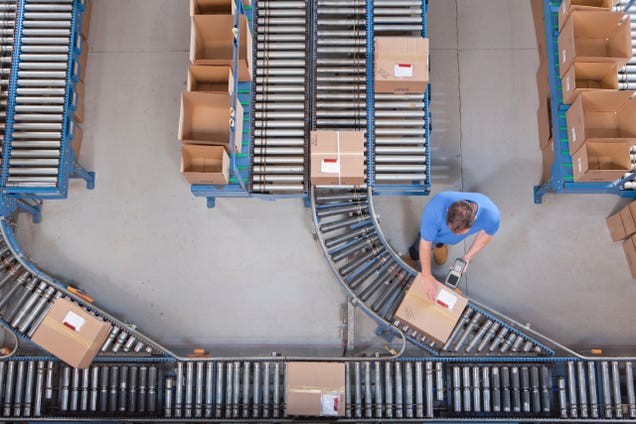How Adobe Photoshop’s generative AI handled holiday warehouse logistics
Much has been made of Adobe’s Firefly AI, the creative software company’s algorithmic model powering tools like vector recoloring in Illustrator, text-to-image effects in Express, and generative fills in Photoshop. After debuting in beta in May, the Firefly-enabled tools made their way to most users this autumn.
We were curious to see how the tools—particularly Photoshop’s—might work, and, looking ahead to the holiday season, decided to dip our inexpert toe into the warehouse logistics waters. With Amazon hiring 67% more workers for this year’s holiday rush, it’s clear that the e-tailer expects huge demand to hit warehouses. So could we use AI to transform its factory floor to meet it?

First, we’re probably going to need a whole lot more conveyor belts
By highlighting sections of the empty canvas, we can prompt Photoshop to expand the edges of the photo—and add way, way, more places to transport all those holiday packages.
And if the holiday ordering surge is as high as Amazon expects, we’re going to see a big build-up of packages. So let’s add them on to the belts we generated.
But, uh, some of these dropped-off boxes are getting pretty weird
Our first try produces some shapes that look like they came from a city skyline, not Santa’s workshop. No worries—we’ll toggle through the three options the AI generates to find ones that resemble a squarer package, similar to the others in the warehouse. The third looks pretty decent.
As we add more packages to stretches of the belt, though, the AI keeps pumping out boxes in strange sizes and configurations. Some are clearly taped and sealed after we prompt them to be empty. Some end up on the floor. Some become a haunted seatbelt-cardboard hybrid when we specify that boxes should be on belts. Eventually, we give up.

Our conclusion
Well, let’s assume Amazon is using some more sophisticated logistical systems. But while the AI is pretty good at expanding the edges of a background, like our warehouse floor, and it’s fun for cycling through AI-generated options, like all those boxes on boxes, it’s still no replacement for any real, human art director (and, we imagine, any real, human warehouse logistics manager).
